The first thing you see as you enter Gouda isn’t really a surprise—it’s cheese. But where the cheese is may be a bit surprising. It’s hanging above the streets. And floating in the canals. And, Thursday mornings in the spring and summer, it’s neatly stacked in rows in the middle of the town square for the weekly Gouda Cheese Market.
Gouda is a place known for its cheese. It’s been that way for hundreds of years. But this city in South Holland, Netherlands, offers many things to do and see in addition to its namesake cheese and famous Dutch cheese market. There are hidden gardens, a secret church, and beautiful buildings also worth visiting. Luckily, the city is so compact that seeing it all in a day is easy.
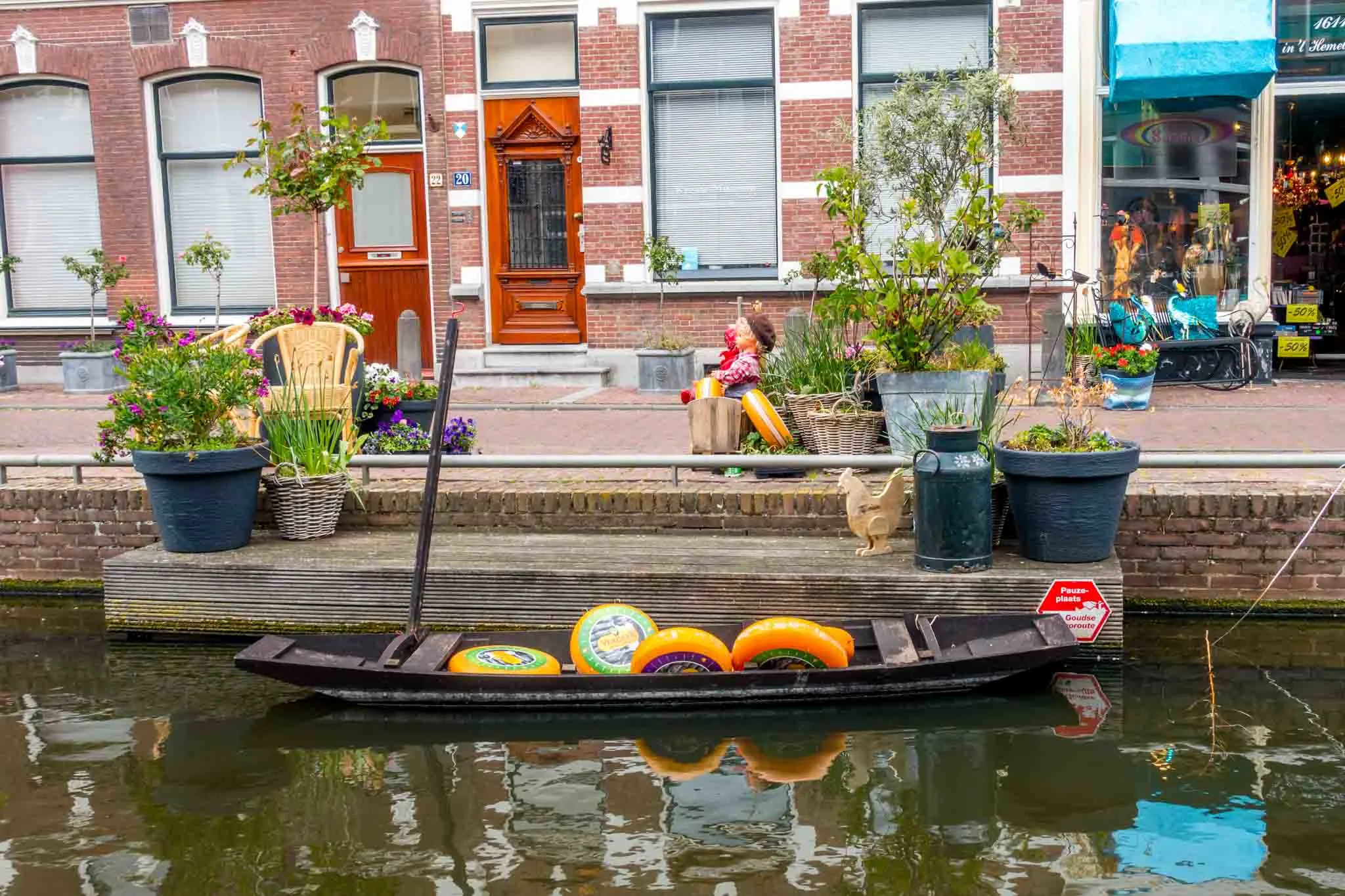
We took a day trip to Gouda to watch the ritual of the intriguing cheese market and to explore the town. Here’s a look at what to expect at the Gouda market plus other fun things to do in Gouda on a quick visit.
- Gouda Cheese Market History
- What Happens at the Cheese Market?
- Can You Taste and Buy Cheese?
- Things to do in Gouda Beyond the Market
- Visit Sint Janskerk
- See the Town Hall
- Shop on Lange Groendaal
- Discover hidden courtyards
- Visit the Weigh House
- See the secret church
- Take a walk down Jeruzalemstraat
- Stroll along the Gouwe River
- Getting Here
Gouda Cheese Market History
As I approached the square, the huge circles of yellowish orange were the first thing that caught my attention. Stacked beneath the beautiful town hall that looks like it was taken straight from a story book, the cheese wheels are the star at the Gouda Cheese Market, as one might imagine.
Gouda, which is pronounced more like “how-duh” in Dutch with a guttural “g” like you’re clearing your throat (sorry), is a yellow cow’s milk cheese. It has a mild flavor that intensifies in nuttiness and caramel notes as it ages. You can find varieties of Dutch Gouda from four weeks old to those aged over a year with the typical flavor as well as additions like pepper, cumin, garlic, and more. This farm cheese—called boerenkaas in Dutch—is made in accordance with traditional production methods and is protected by the European Union.
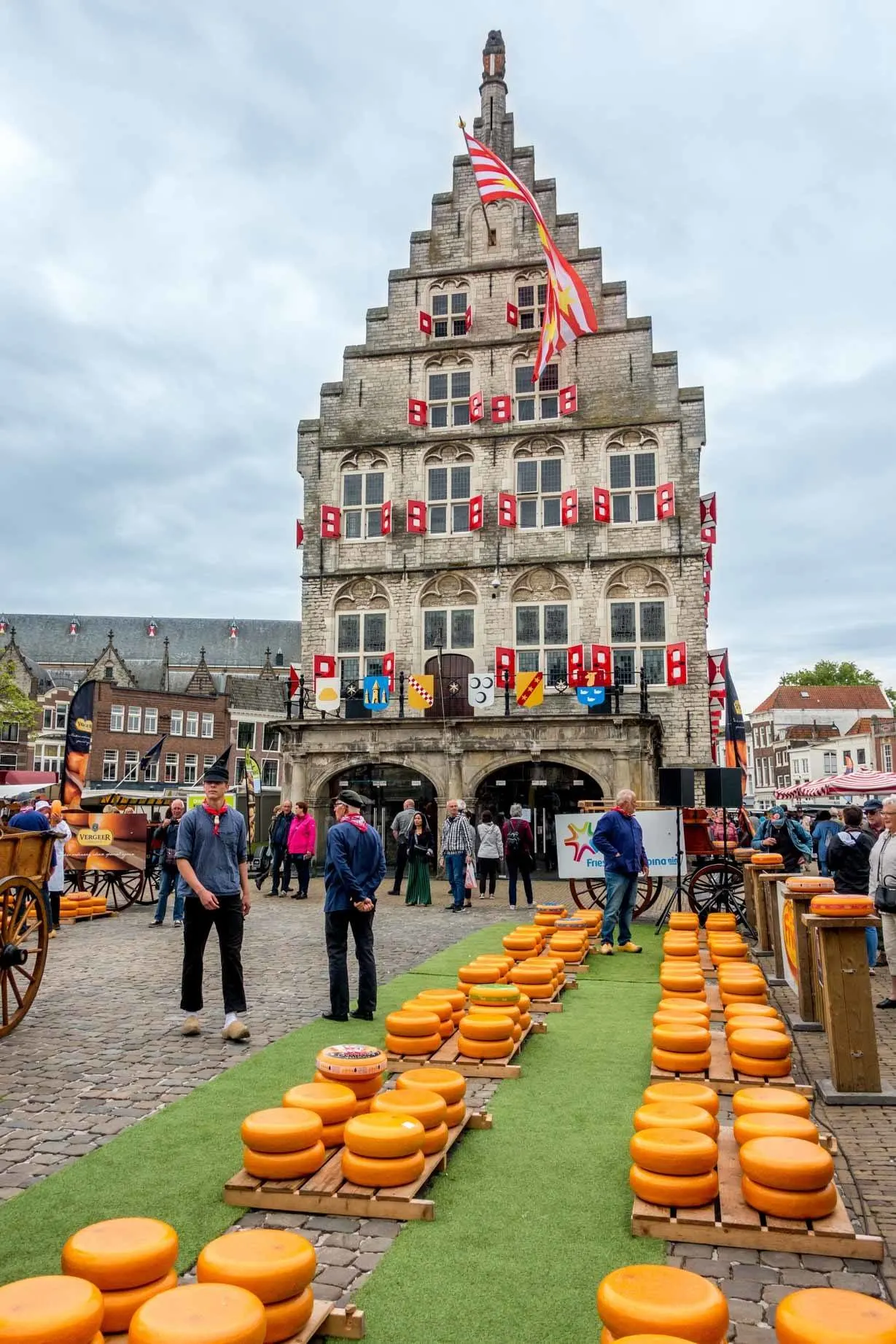
The market selling the traditional cheese has been held in this spot for centuries. The first mention of Gouda cheese goes all the way back to 1184, making it one of the oldest recorded cheeses still being made today (like one of our other favorites, Parmigiano-Reggiano).
Gouda cheese is named after the city of Gouda not because it was produced in the city, but because it was traded here. In the Middle Ages, it was the only place where local farmers could legally sell their cheese, giving rise to the market rituals that are still repeated each week.
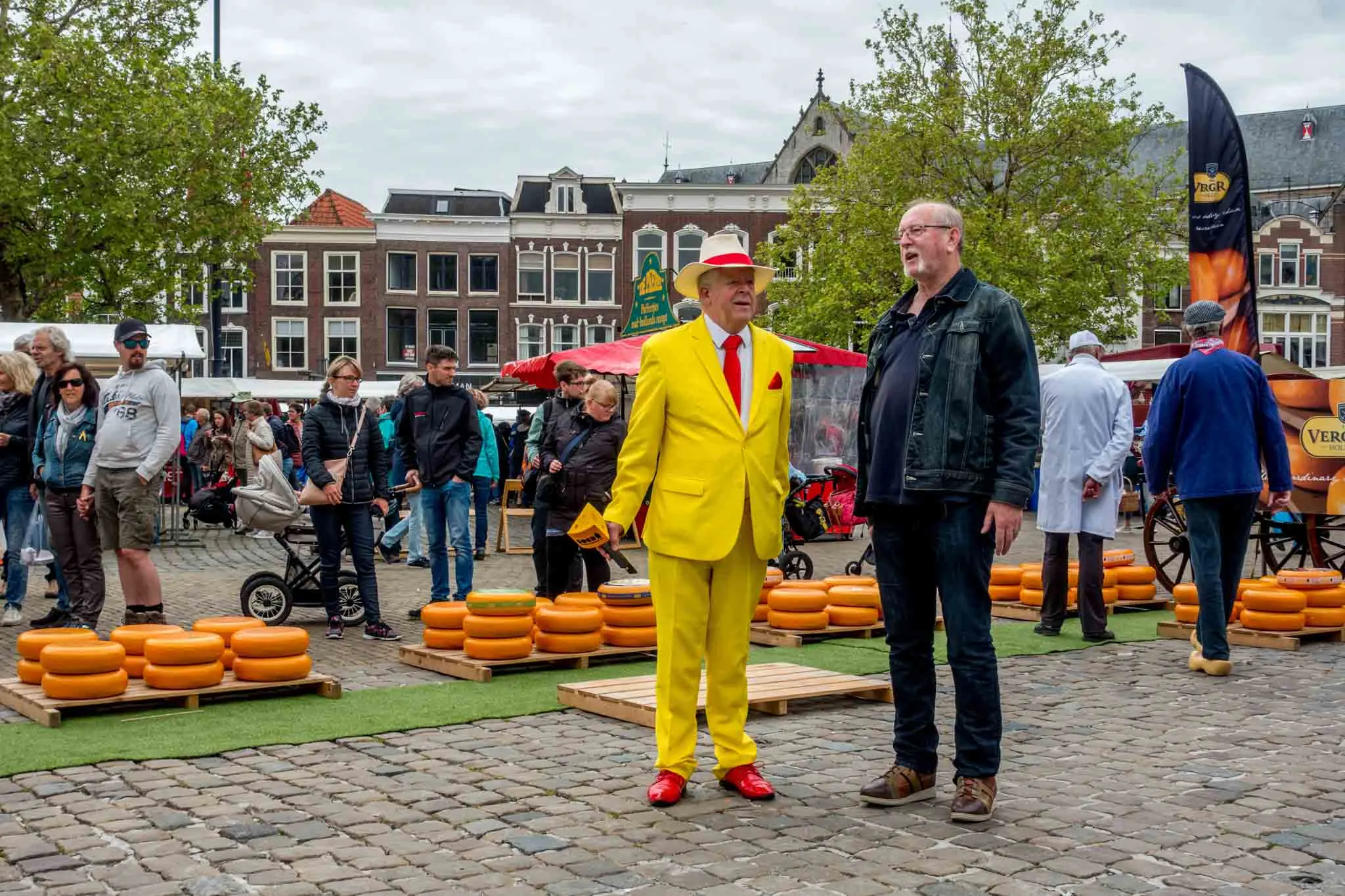
What Happens at the Cheese Market?
Thursday mornings from April through August, cheese sellers arrive early in their horse-drawn carriages. Cheese porters unload the 30-pound wheels, placing them neatly in the square between the Town Hall (Stadhuis) and the Weigh House (De Goudse Waag). For the next 2.5 hours, the buyers and sellers go through their negotiation process, all to make a deal on this famous cheese.
There is a little bit of raising of voices, a little bit of head shaking, and a little bit of compromise (at least I think that is what’s happening, as it’s done all in Dutch). Buyers sample the cheese, and they often share a bite with fortunate visitors nearby, just to make sure that everyone is happy with the product. I was lucky to get a bite, and I’m sure it was worth whatever price was paid.
Then they seal the deal. In a ritual system called handjeklap, buyers and sellers clap each other’s hands repeatedly, shouting prices until they reach an agreement. It happens numerous times throughout the market, and, every time, visitors run to watch. Other than actually tasting the cheese, watching the centuries-old negotiation process is the highlight of the market.
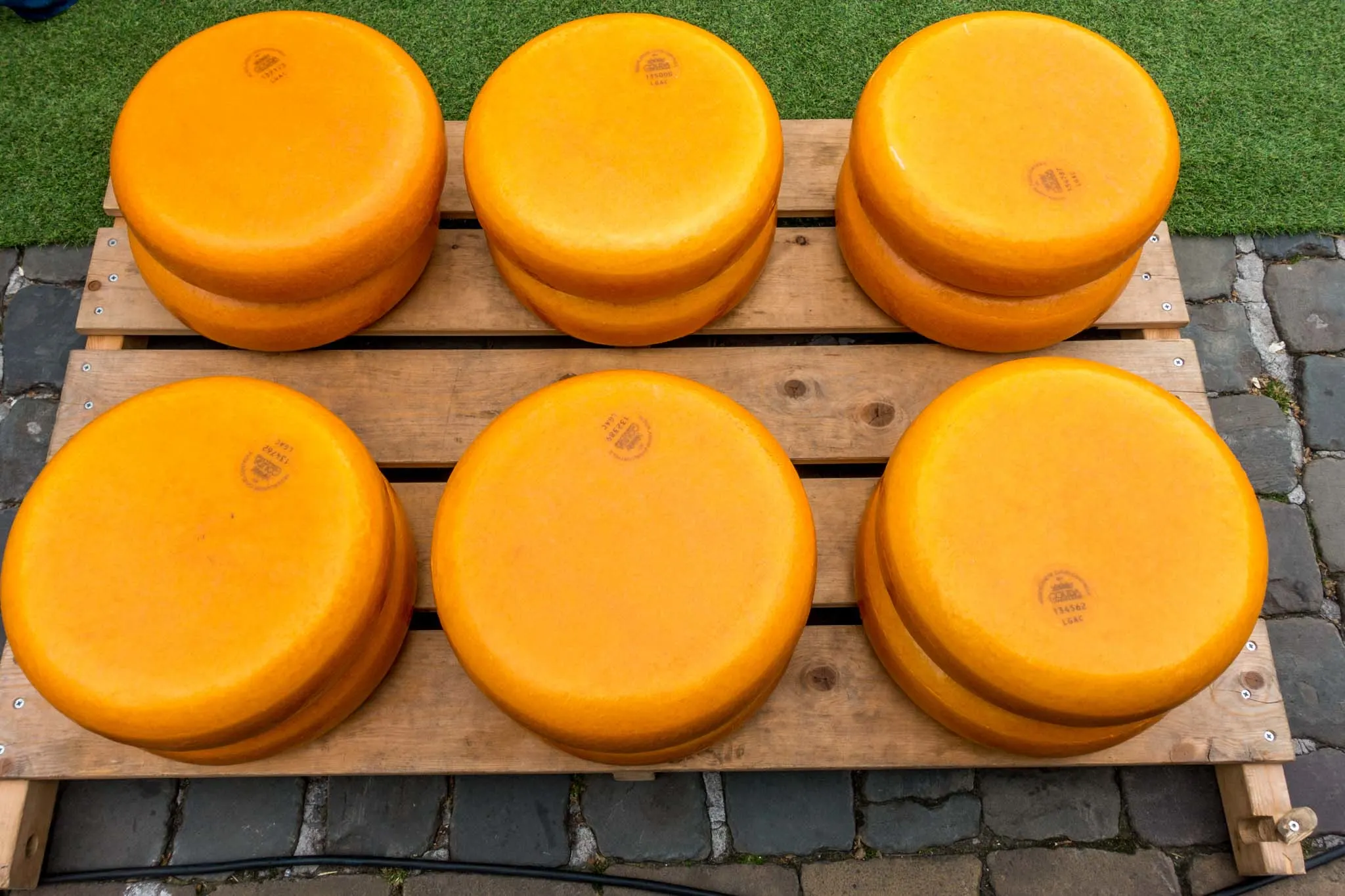
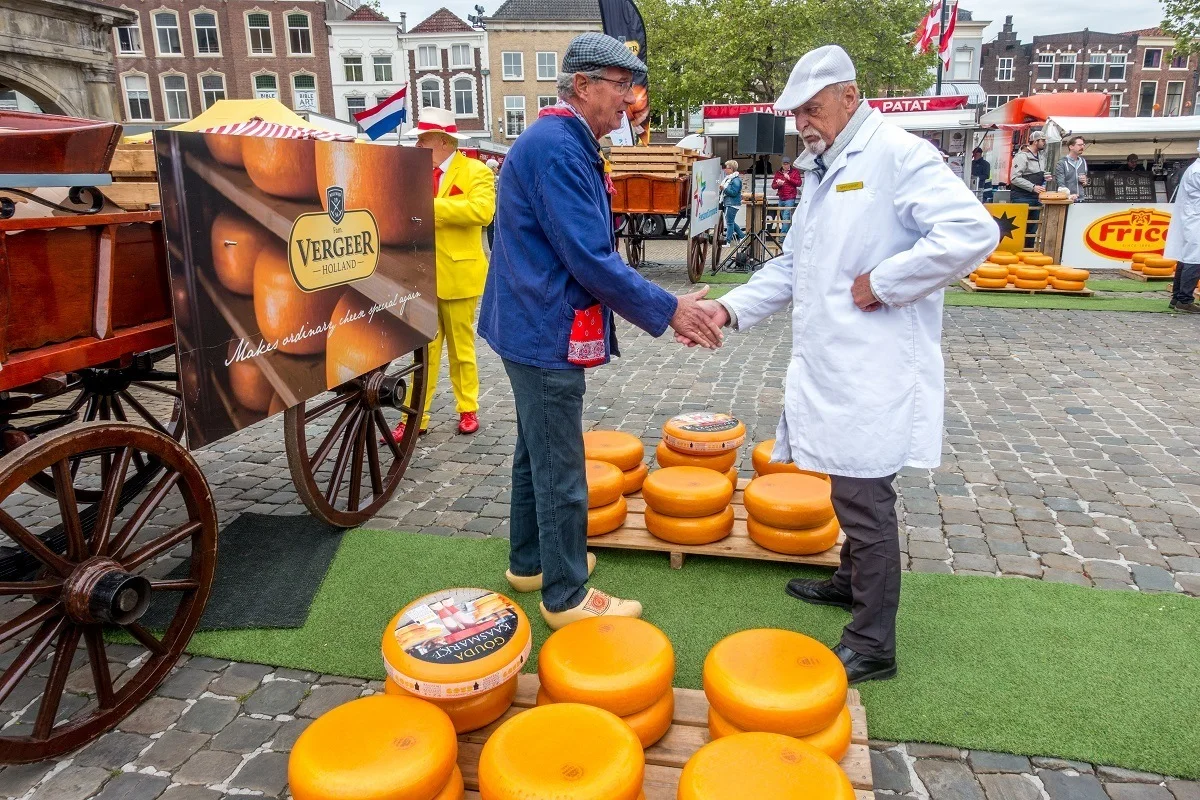
After a price is agreed on, the cheese porters clomp around in their wooden clogs on the cobblestones and pitch the cheese back into the wagon. At every step, a man in a loud yellow suit with a cheese microphone recounts the happenings for the crowd over the sound system.
The theatrical market is now for the tourists rather than the cheese buyers and sellers. But knowing that the market is just for show doesn’t take away from the excitement of seeing the tradition play out. It was one of the highlights of our trip to the Netherlands.
Can You Taste and Buy Cheese?
Surrounding the historical cheese market, there are lots of things for sale. Anyone who wants to can buy their own Gouda or other types of Dutch cheese. Whether you’re looking for unusual flavors like mustard or walnut or want to stick to more traditional old or young cheese, there are many options to taste and choose from—just browse the aisles. You may even see fresh cheese being made on site.
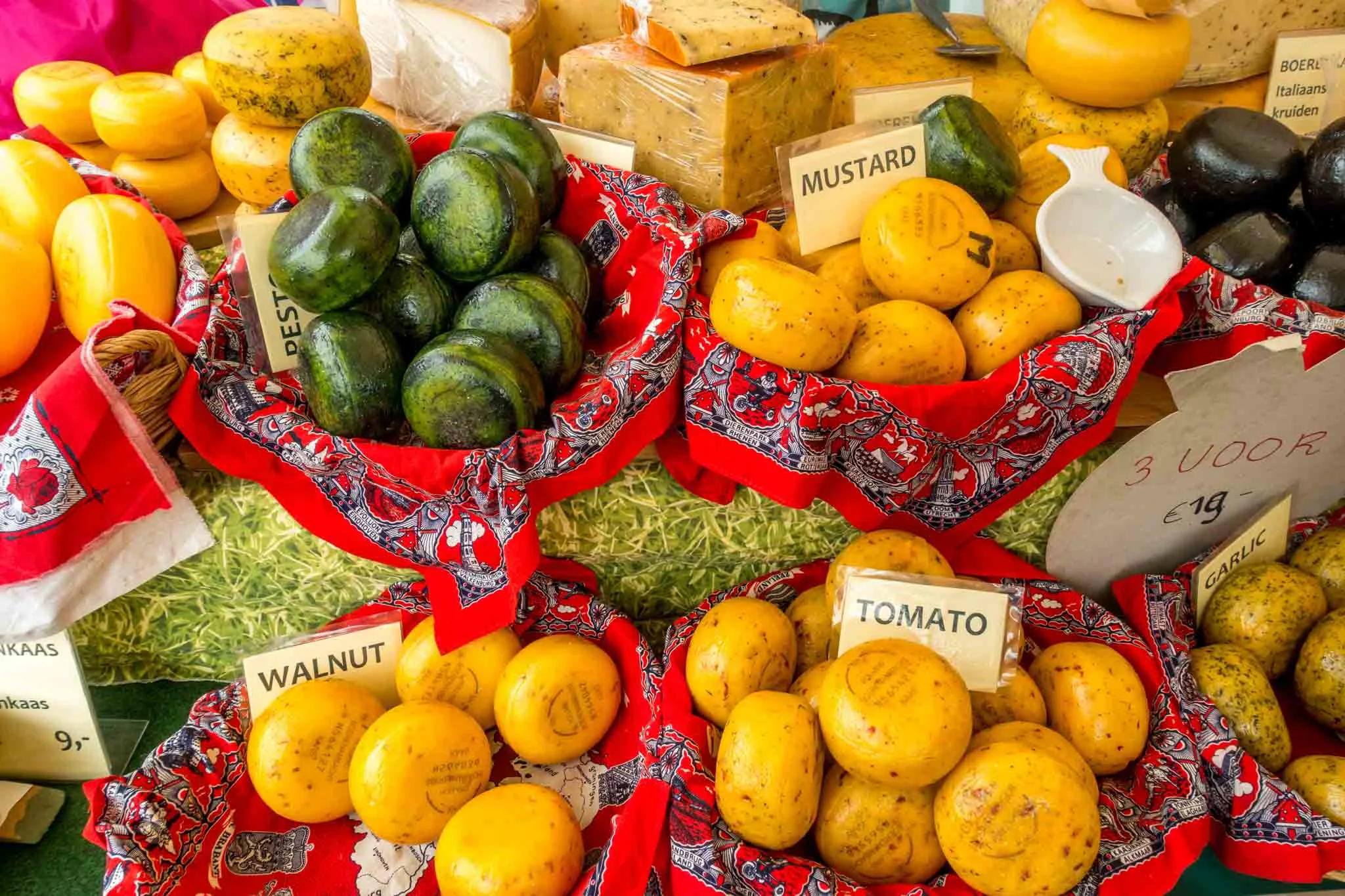
Options in the market go well beyond cheese with lots of traditional Dutch items. This is a great place for trying traditional Dutch foods like silver-dollar-sized pancakes called poffertjes (a personal favorite) or the gooey, crunchy stroopwafels that Gouda is known for.
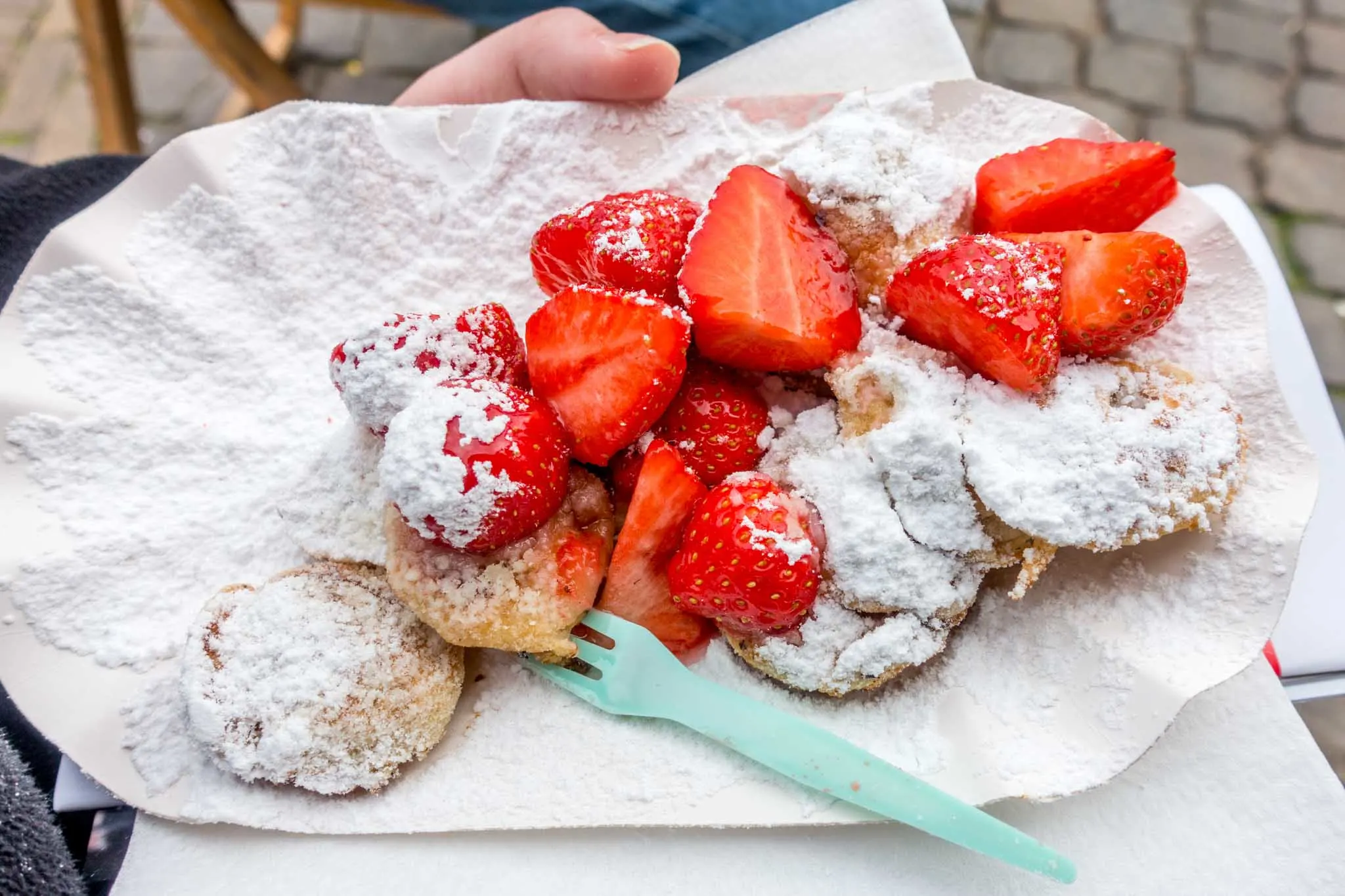
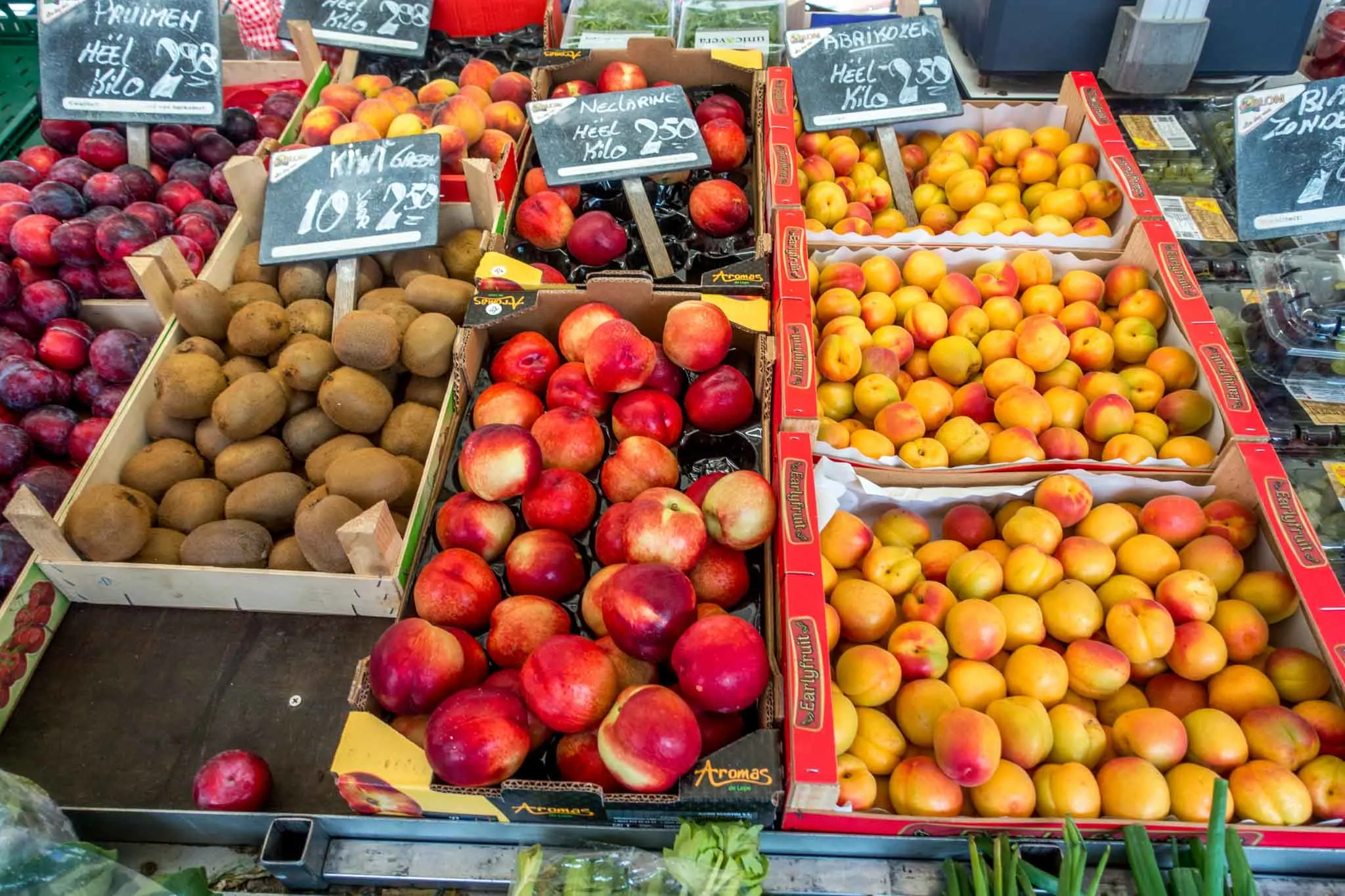
Parts of the market are more geared for tourists, but there are many stalls designed to appeals to locals. As a result, you’ll see people shopping for their weekly groceries as well as clothes and other household items. During the height of the season, there’s also a craft market where you can stock up on gifts and souvenirs.
For a snack or lunch on the go, there are stands selling fresh frites, sandwiches, and other goodies.
The traditional cheese market ends at 12:30, and most of the other stands were packed up between 1:00 and 2:00pm.
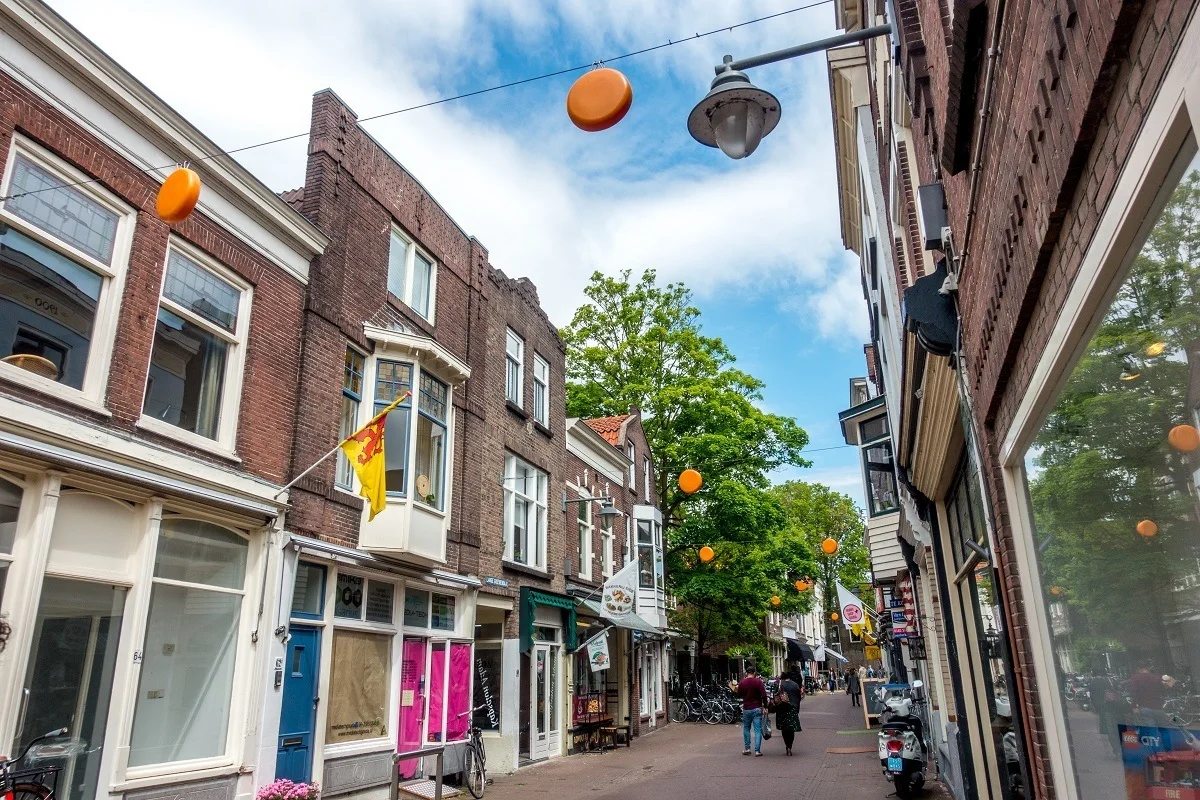
Things to do in Gouda Beyond the Market
If your goal in Gouda is simply to see the cheese market, your visit can be finished in a couple of hours. But it’s great place to visit and one of the most charming cities in the Netherlands. It is worth some time to explore, even after the market is finished.
Visit Sint Janskerk
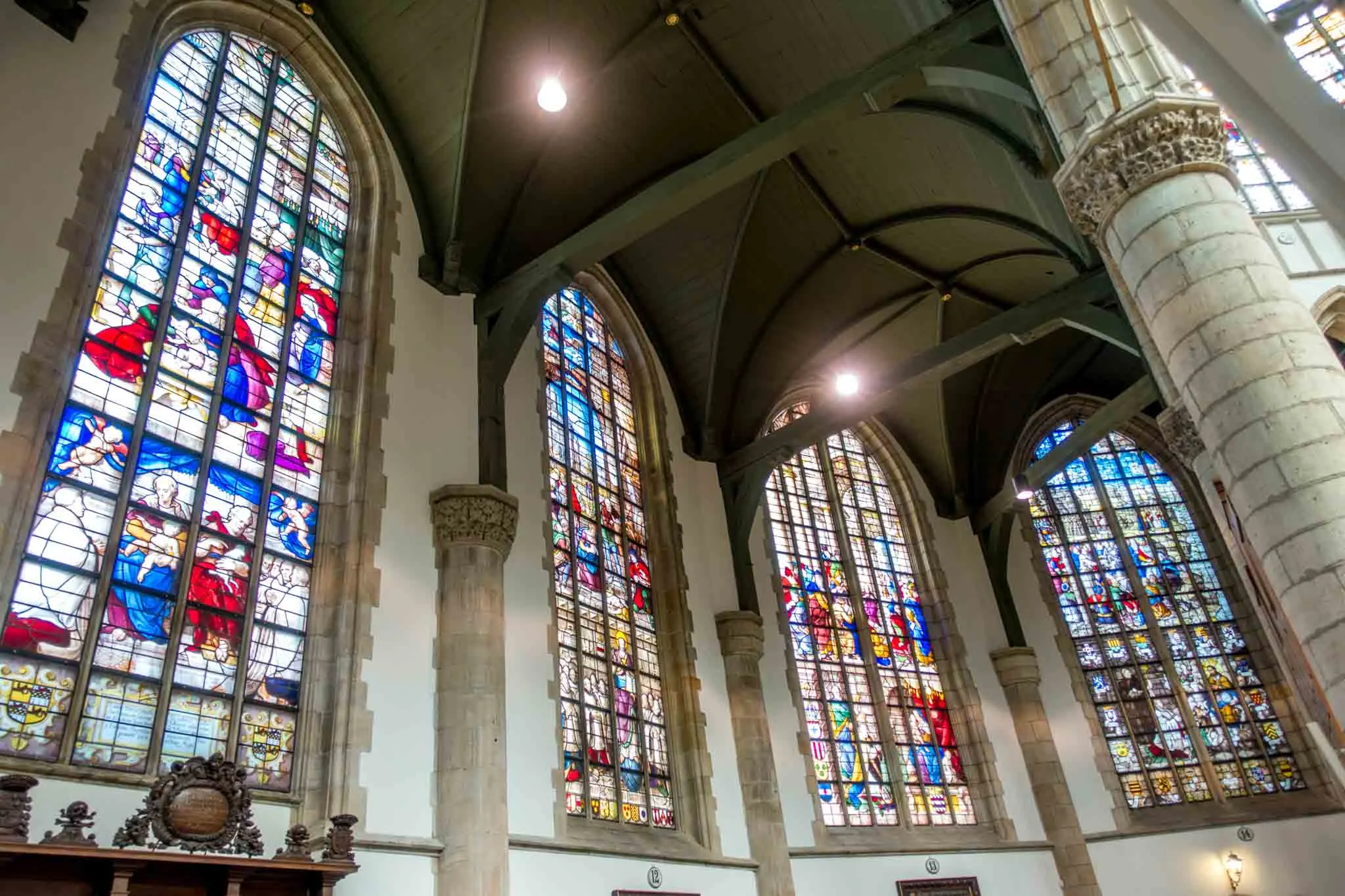
The 15th-century Gothic Church, Sint Janskerk, is one of the top places to visit in Gouda. Dedicated to St. John the Baptist, the patron saint of the city, the church is most famous for its soaring stained glass windows that date from the late 1500s. Surrounded by the majestic colors in the windows, you can see the medieval style giving way to the Renaissance aesthetic.
Like many other churches in the Netherlands, the contents of Sint Janskerk were scavenged and destroyed during the Reformation. But unlike some other institutions, its stained glass was left alone. Thanks to preservation efforts, it also survived World War II and has landed Sint Janskerk a place on the list of top Dutch heritage sites.
See the Town Hall
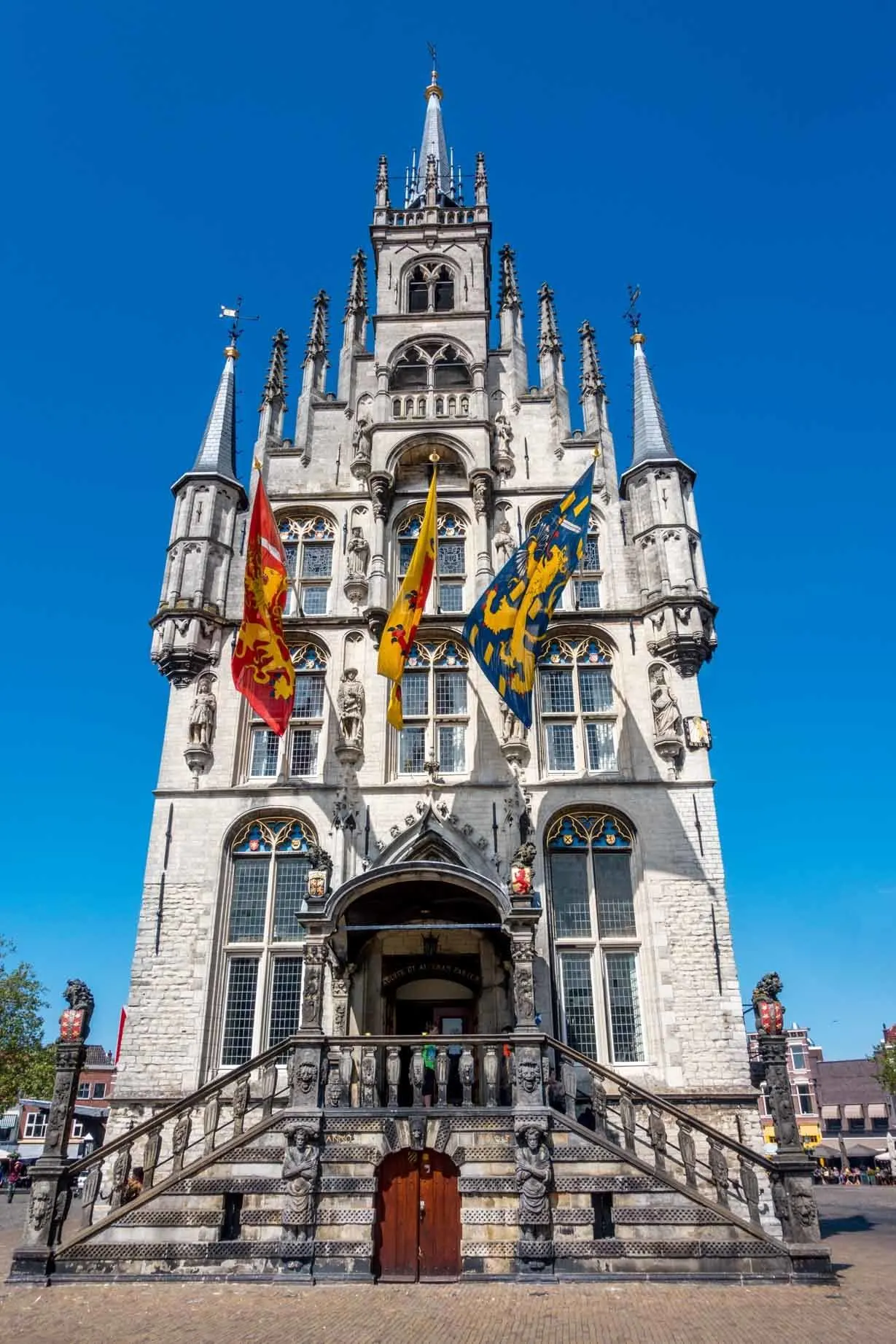
Gouda’s dramatic Town Hall is one of the most gorgeous buildings in town. The free-standing structure built between 1448 and 1450 lords over Markt square with its stunning turrets and brightly-colored flags.
If the doors are open, it’s possible to visit the wedding room, the mayor’s office, and council chamber. On the half-hour, you can also watch the mechanical puppets of the carillon come to life. The building is open every day except Monday as long as there are no weddings or special events.
Shop on Lange Groendaal
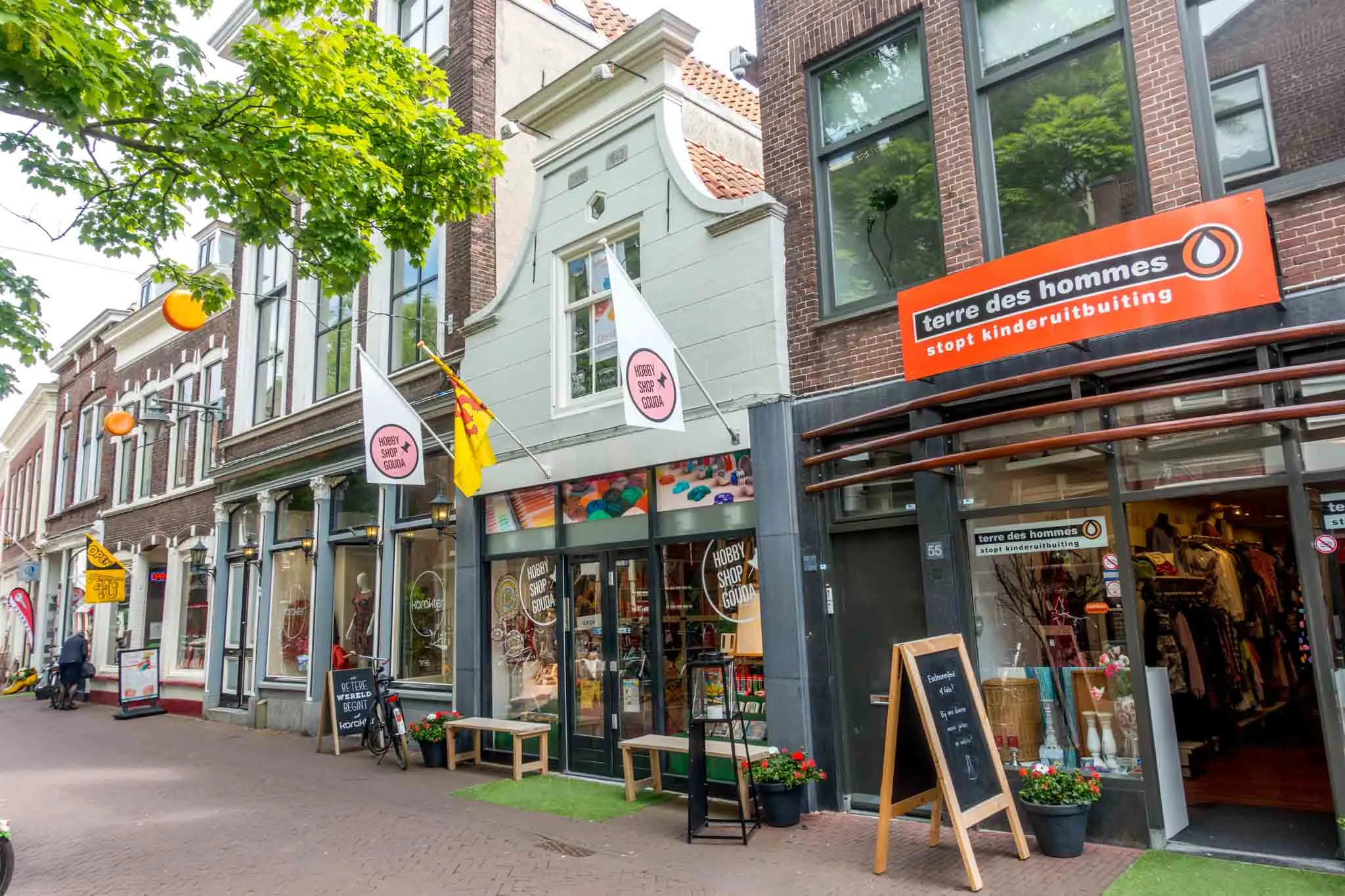
Just off Markt Square, you’ll find Lange Groendaal, one of the streets with cheese wheels dangling above it. This cute shopping street is filled with independent boutiques, cafes, and a few Dutch chain stores.
Check out De Speeldoos, the unique Dutch toy store, or stop into a tea house or bakery for a quick bite. In Karakter, you’ll find relaxed casual clothes, or check out the second-hand store Terre des Hommes, which dedicates its profits to programs stopping child exploitation around the world.
Discover hidden courtyards
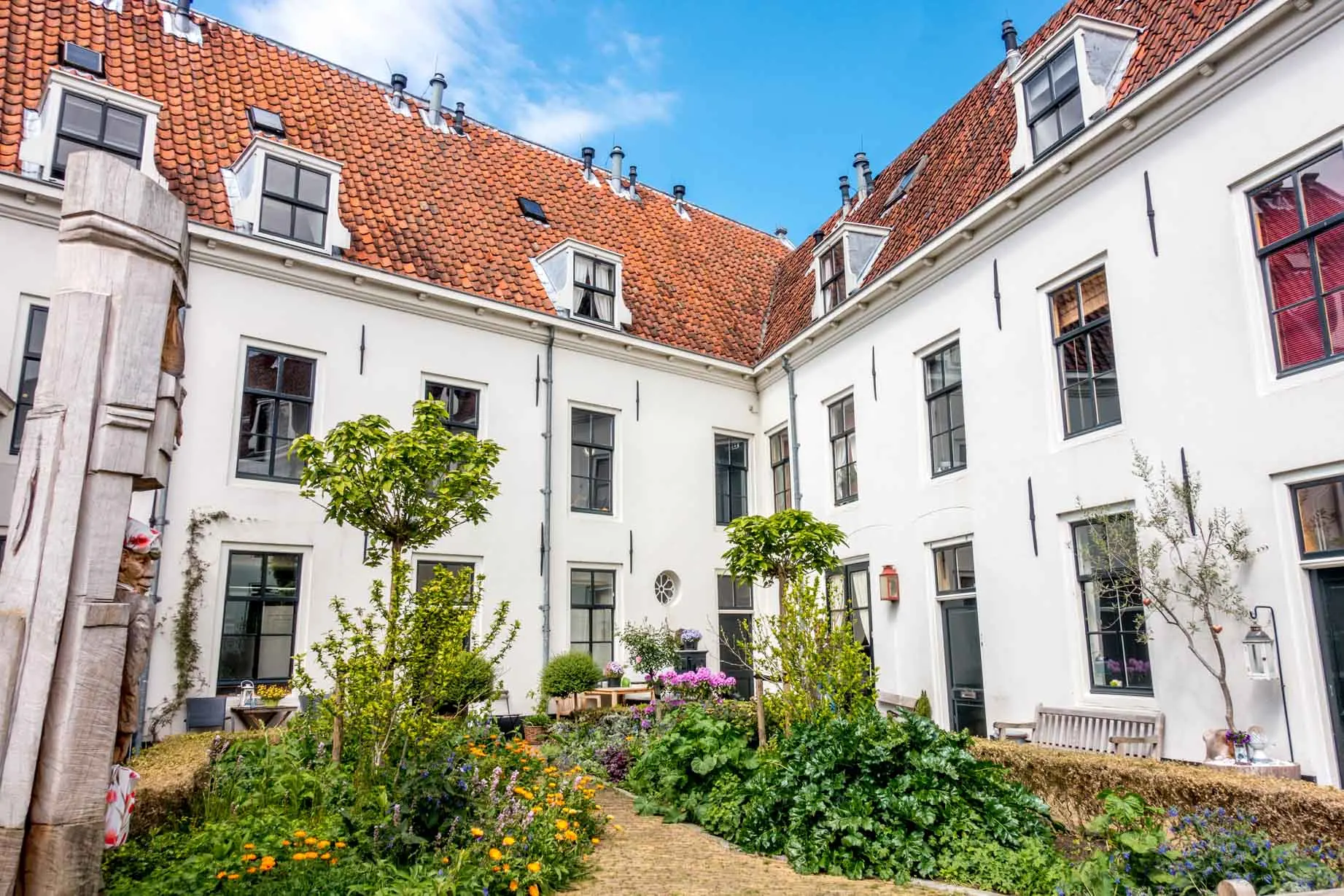
The Netherlands is full of hidden courtyards called hofjes, the Dutch word for an almshouse surrounding a courtyard. Many of them have existed since the Middle Ages to provide housing for the elderly and those with low income.
It’s often hard to find hofjes without knowing they’re there because these little havens of quiet beauty hide behind nondescript doors. They are only open at certain times, and we often found them closed to the public even during the appointed opening hours (they are private residences, after all). In Gouda, you may be lucky to find a few of the gems with their doors open.
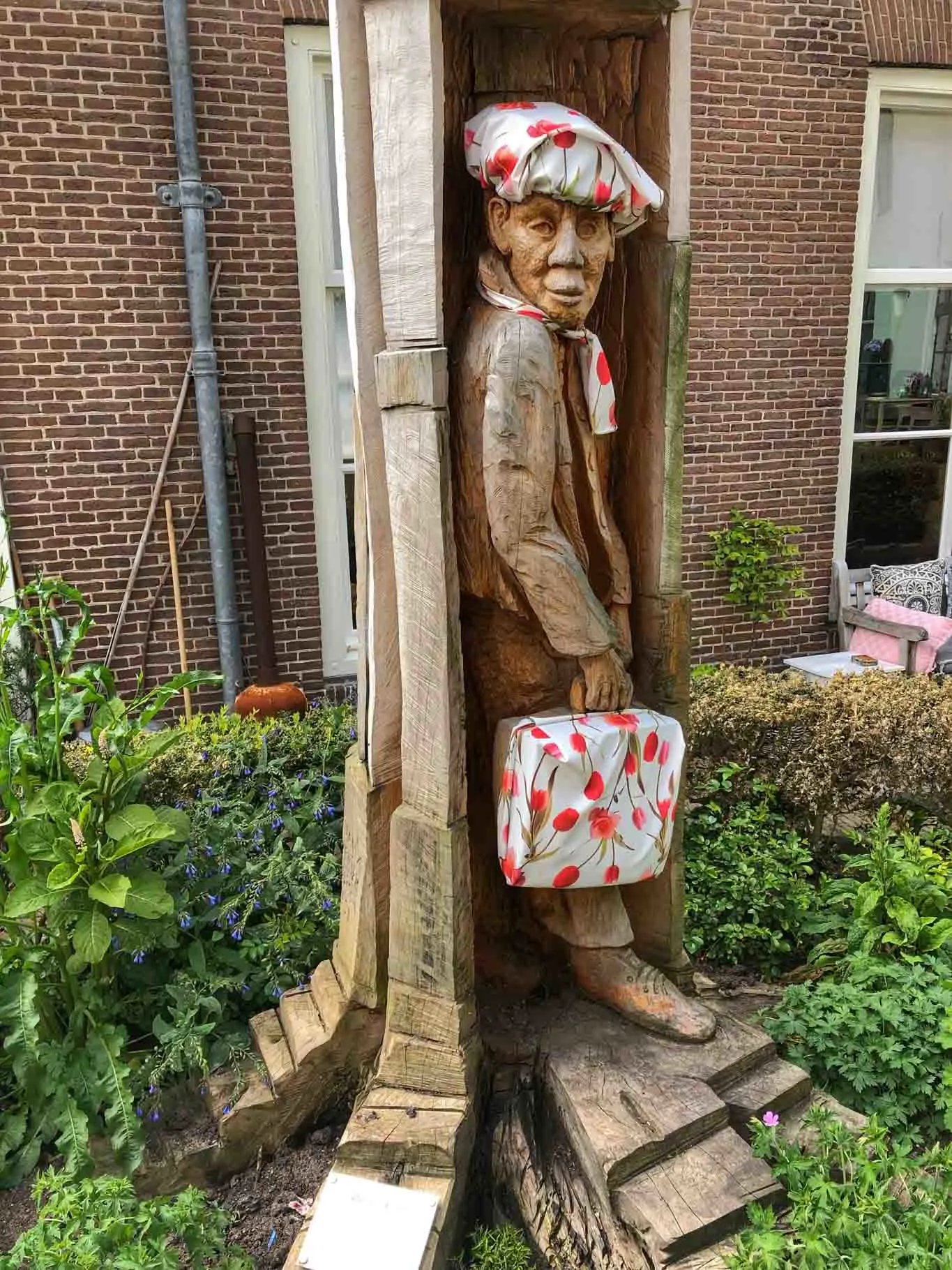
Hofje van Cincq is considered to be one of the most luxurious such houses in the city, but we were most intrigued by Willem Vroesenhuis. This hofje–founded in 1555 and named after its benefactor Willem Vroesen–is one of the few originally set aside for male residents. Its inner courtyard was filled with well-tended plants and lovely carvings. Across the street by Sint Janskerk is the property’s original front garden now called Willem Vroesentuin.
If you visit any of the hofjes in the Netherlands, keep in mind that they are private residences, and respect the posted hours and the residents’ privacy.
Visit the Weigh House
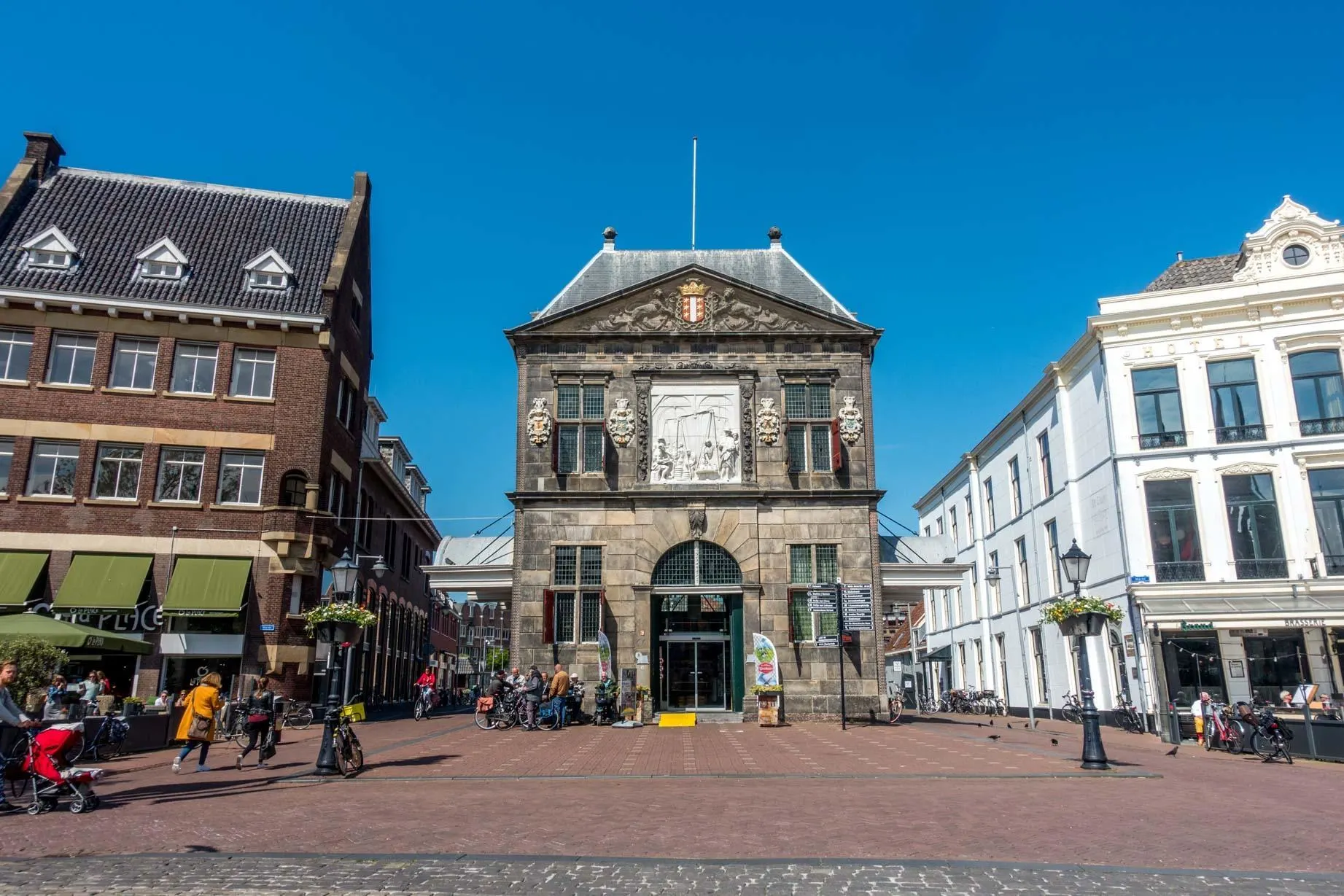
Designed in 1668, De Goudse Waag–aka the Weigh House–was where cheese and other commodities were weighed to determine prices and taxes. During the cheese market, you can still see the scales in action.
Today, the De Waag is Gouda’s Tourist Information Center and the home of the Gouda Cheese Museum. In the museum, visitors can learn about the building’s history, the items that were traded here, and how the famous farm cheese is made. It can get crowded during the market but is much easier to visit later in the day.
See the secret church
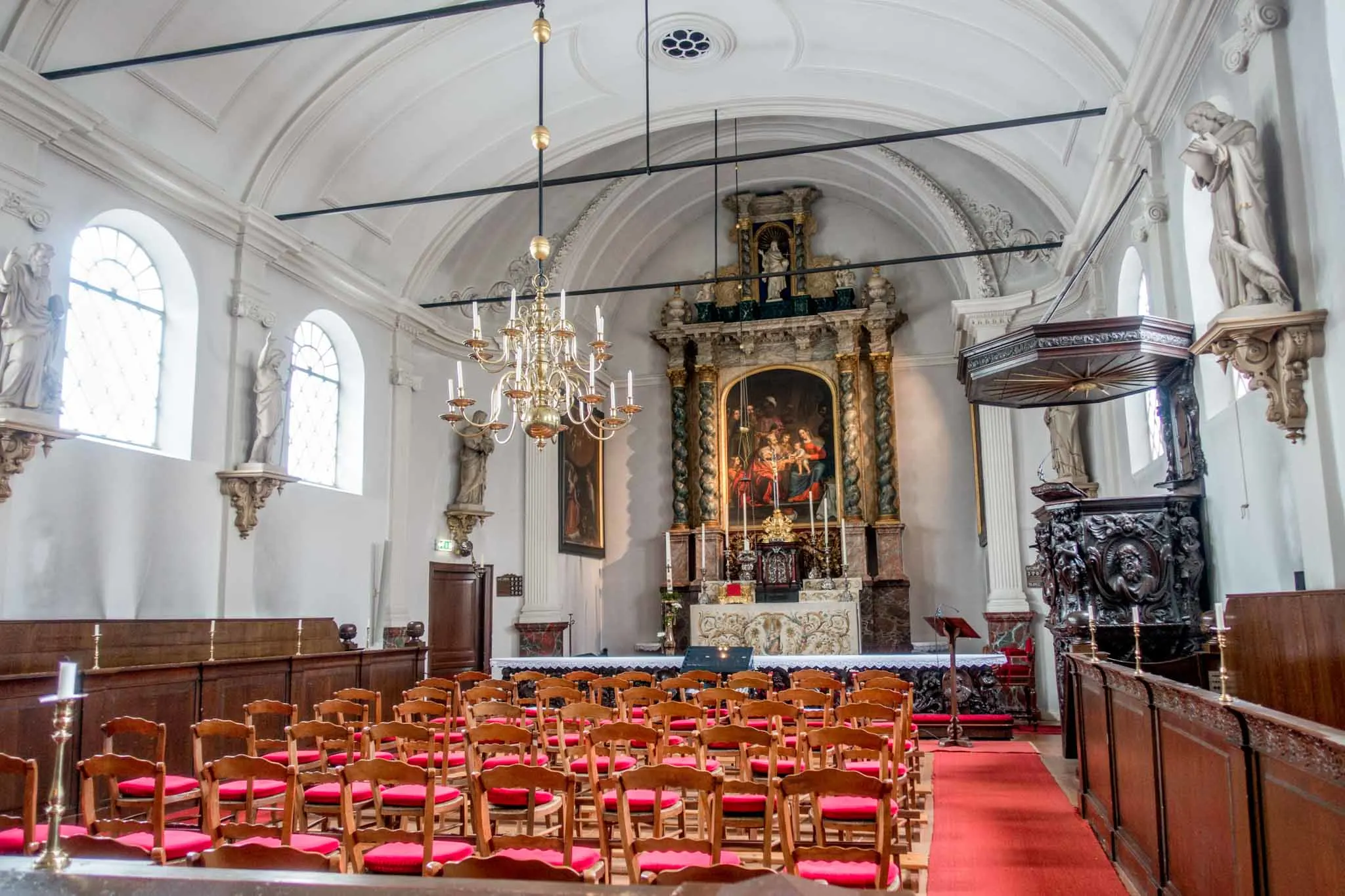
Just outside the doorway of the hidden Old-Catholic Church (Oud-Katholieke Kerk), a banner announced in a mix of Dutch and English that, “De Kerk is open.” Centuries ago, however, the church’s existence could not be nearly so overt.
In the 1600s, following the Reformation, Catholics were not allowed to practice their faith openly. This led to a series of clandestine churches (like my favorite Our Lord in the Attic in Amsterdam) that looked like regular homes or office buildings on the outside but concealed churches on the inside. In 1632, Gouda’s Old-Catholic Church was set up in just this way inside two canal houses. Even now, it’s hard to find the sanctuary when you enter the church–a kind parishioner showed us the way.
Seeing the church is a unique experience and a trip back to a different religious time. It’s definitely worth a stop if the church is open.
Take a walk down Jeruzalemstraat
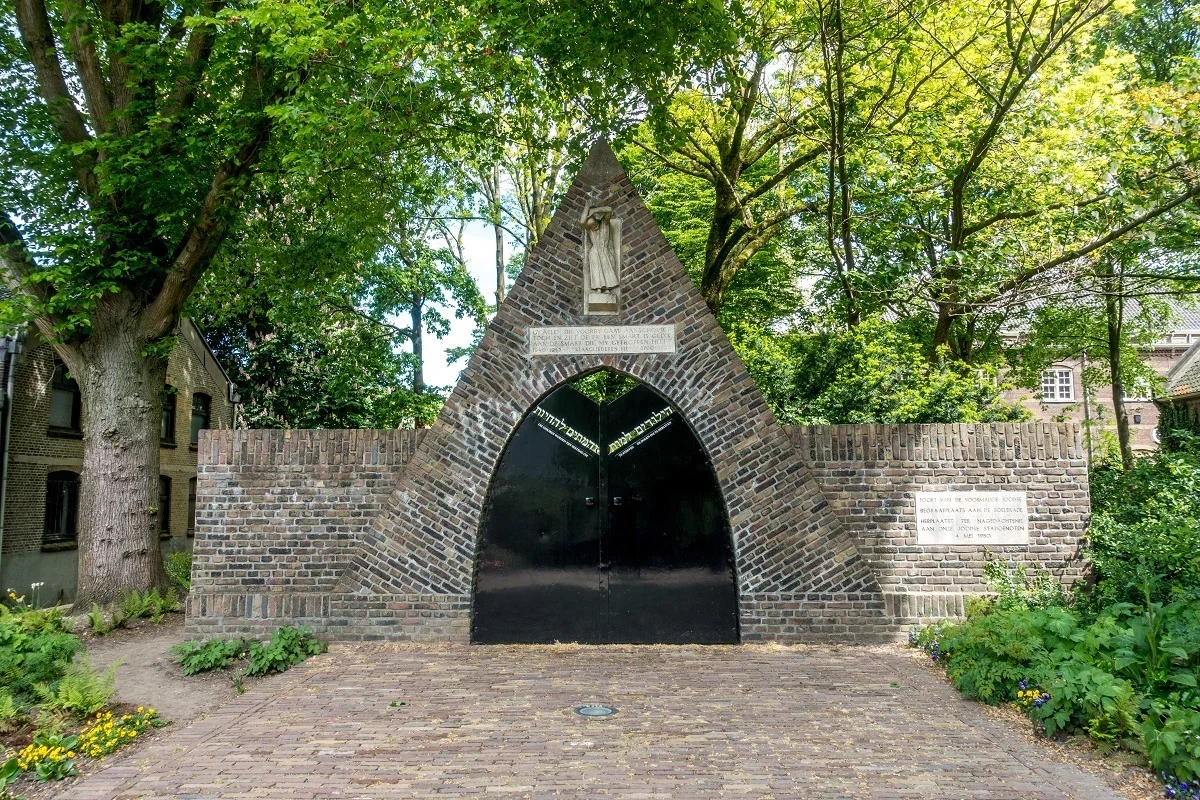
Like other cities in the Netherlands, Gouda had a thriving Jewish population before World War II. On Jeruzalemstraat, you can see a triangular monument at the gate of the former Jewish Cemetery, which is now a memorial to residents who perished during the Holocaust. The gate is located on a plaza called Raoul Wallenbergplantsoen, named after Raoul Wallenberg, a Swedish diplomat recognized for saving tens of thousands of Hungarian Jews by providing certificates of protection and forged documents.
A few steps down the street is the 16th-century Jerusalem Chapel, a 12-sided building with striking stained glass windows. It might be easy to overlook the chapel, but its harder to miss the former orphanage with bright red shutters and a magnificent roof next door.
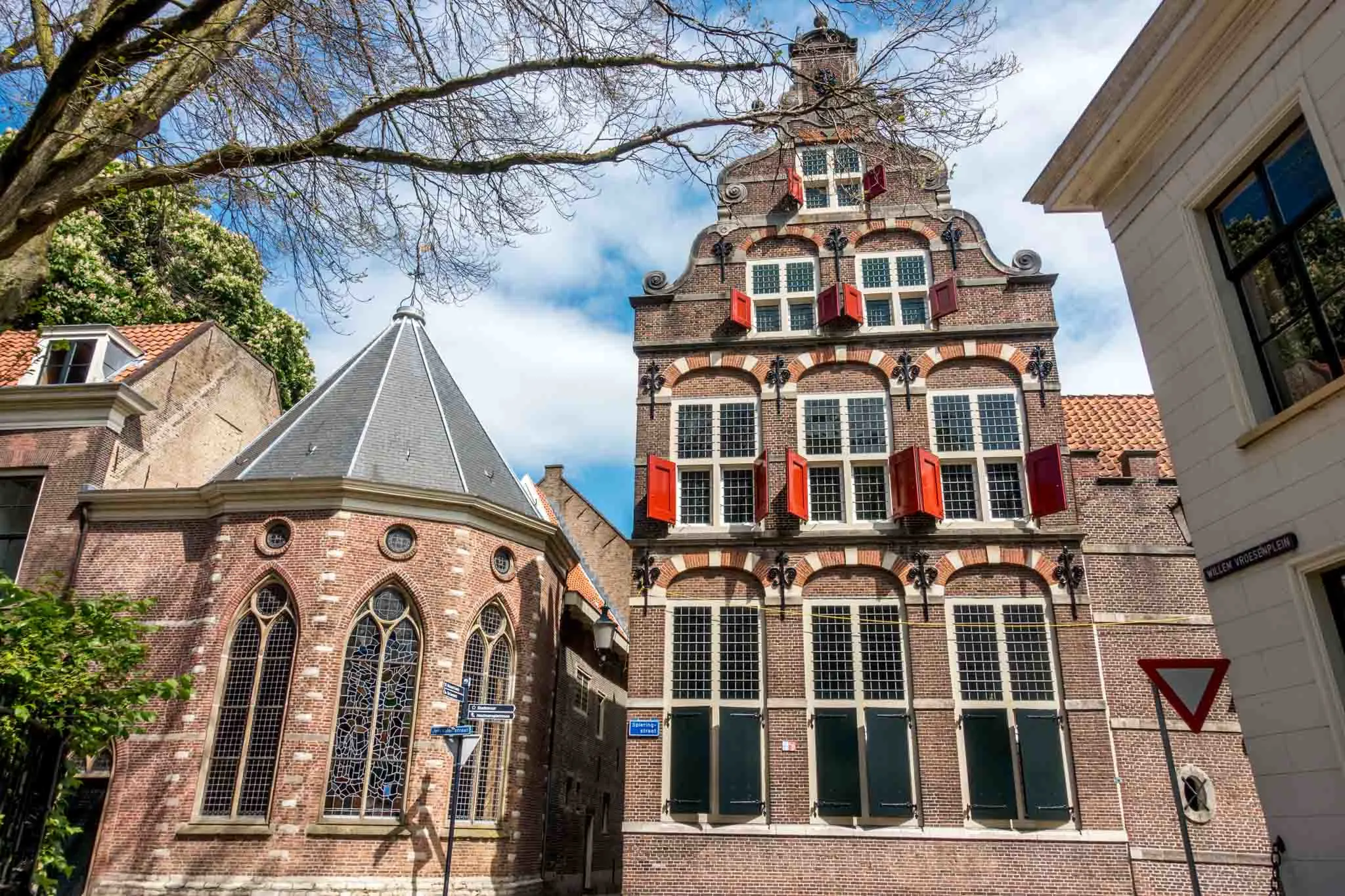
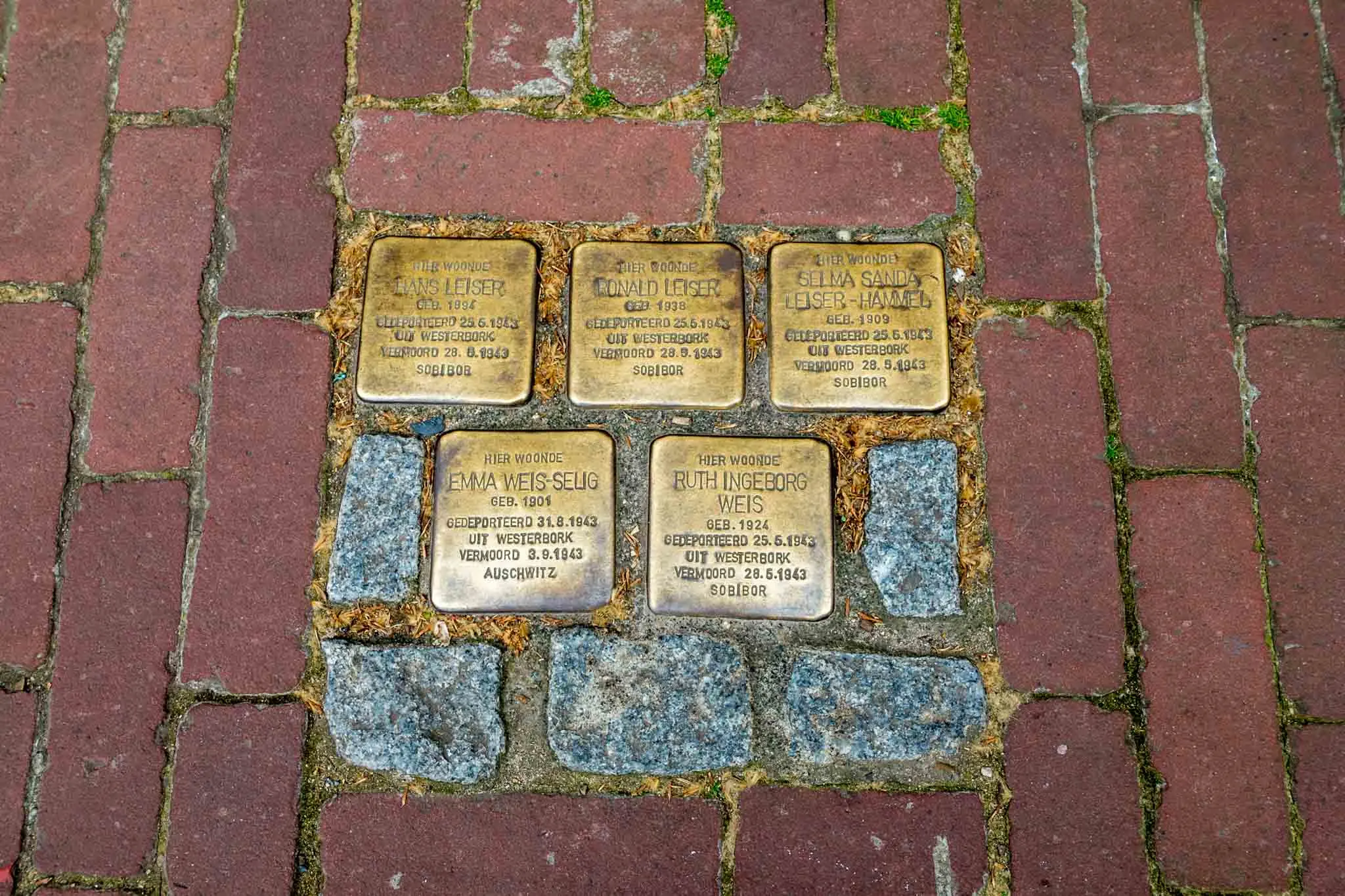
For those interested in other Holocaust memorials, keep a look out for golden squares embedded in the sidewalks around town. These stumble stones (stolpersteine) are placed at the last chosen residence of people who were captured by the Nazis. They show the person’s name, birthday, date of death, and other important information. There are nearly 200 in Gouda, paying tribute to residents who died.
There are more than 70,000 stumble stones worldwide. Collectively, they form the world’s largest decentralized memorial. We try to make a point to photograph them whenever we see them.
Stroll along the Gouwe River
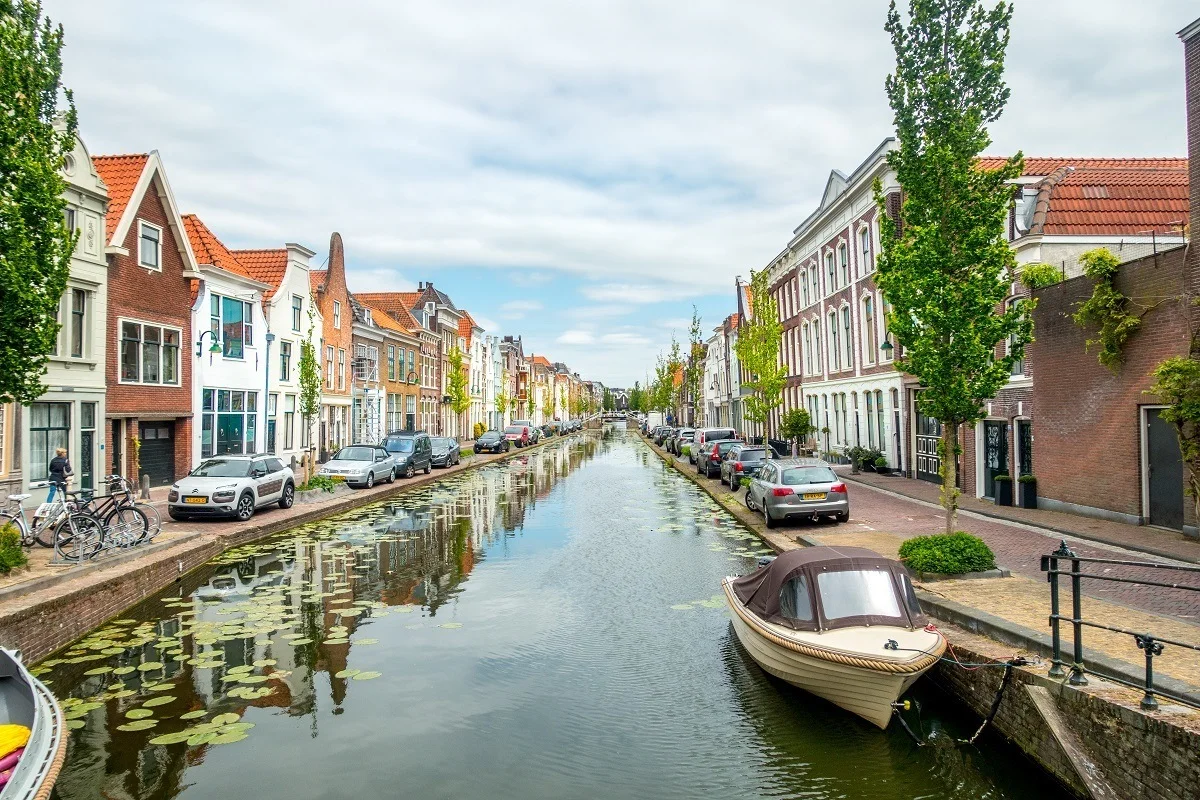
Not far from the Markt and Sint Janskerk, the Gouwe River forms a canal lined with boats and charming buildings. You can stop at some of the galleries and shops and take a peek into the Sluiswachtershuisje, the lock keeper’s house, where a “keeper” still keeps watch.
Getting Here
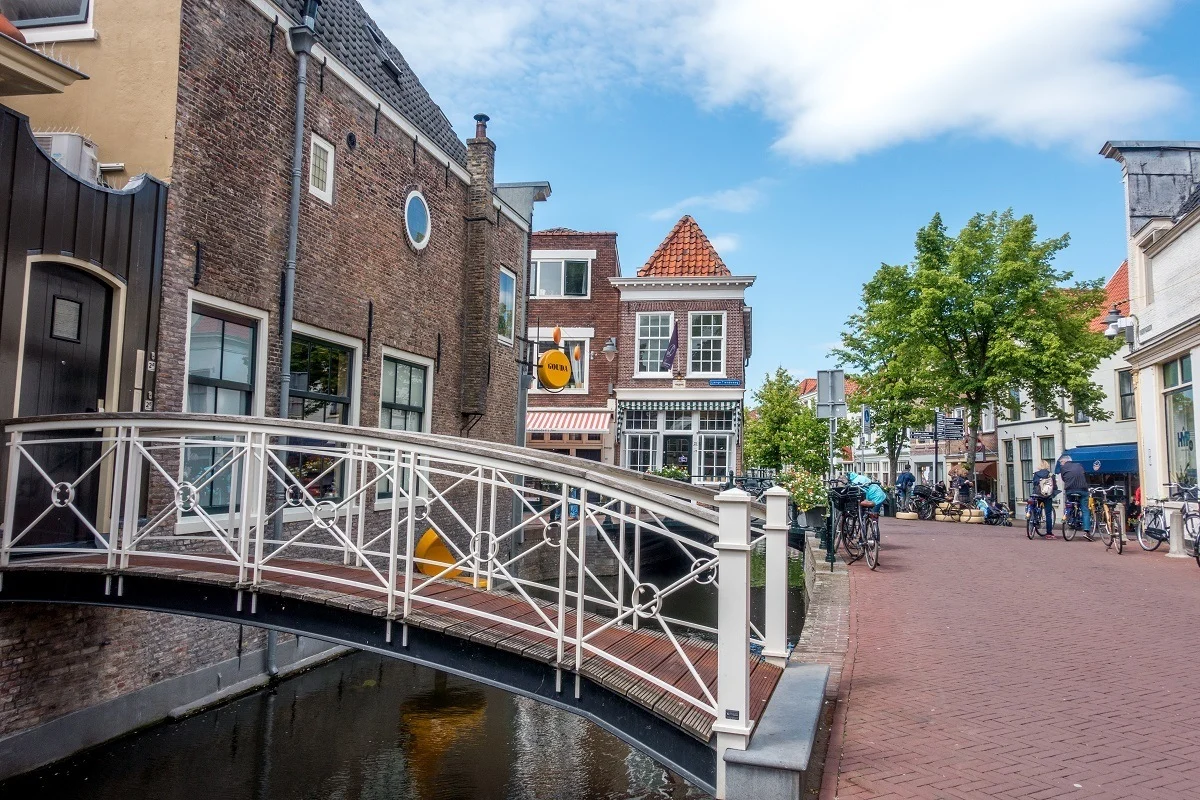
Train service in the Netherlands is excellent, and it’s easy to reach most places in Holland in an hour or less. Gouda makes a great day trip from Amsterdam because it’s only about 50 minutes by train, which run frequently. Coming from Rotterdam, it’s about 25 minutes, and the trip from The Hague will take 20-30 minutes, depending on the route.
The market takes place between the Waag House and the Town Hall, which is a 10-minute walk from the train station. Just walk toward the center of town and follow the signs.
The market runs from 10:30am-12:30pm. Though action continues throughout, we found that things died down a bit around 11:45. As deals are made, the cheese is taken from the square, so there was a little less to see as the market progressed. The town was very quiet again by 2:00pm, which presented a great opportunity for sightseeing without crowds.
Laura Longwell is an award-winning travel blogger and photographer. Since founding Travel Addicts in 2008, she has written hundreds of articles that help over 3 million people a year get the most out of their travel. In that time, she has visited nearly 60 countries on 5 continents, often returning to favorite destinations over and over again. She has a deep love of history, uncovering unexpected attractions, and trying all the good food a place has to offer.
In addition to Travel Addicts, Laura runs a site about her hometown of Philadelphia—Guide to Philly—which chronicles unique things to do and places to see around southeastern Pennsylvania. Her travel tips and advice appear across the web.

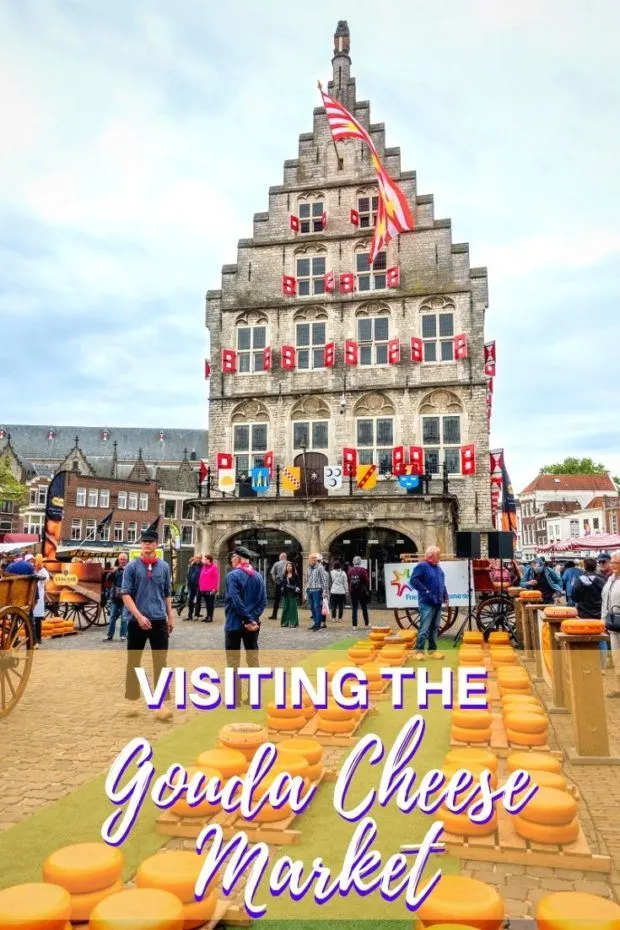
Venkatram
Wednesday 11th of August 2021
Very informative and with sensitivity (reference to stumble stones (stolpersteine)). Thank you.
Annet Vreeswijk
Monday 8th of July 2019
On the cheese market you can also buy the cheesewaffle. This is a waffle with a slice of Gouda cheese in the middle. You eat it warm when the cheese is melted. It’s really good and i’m sure you love it!